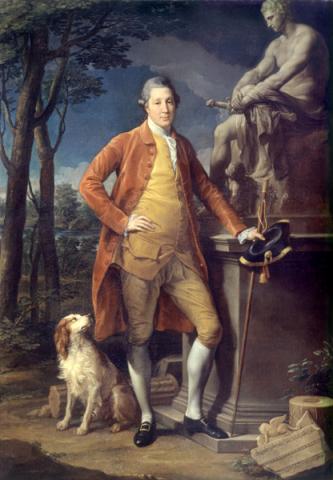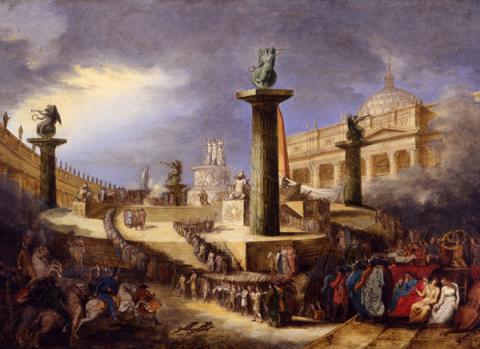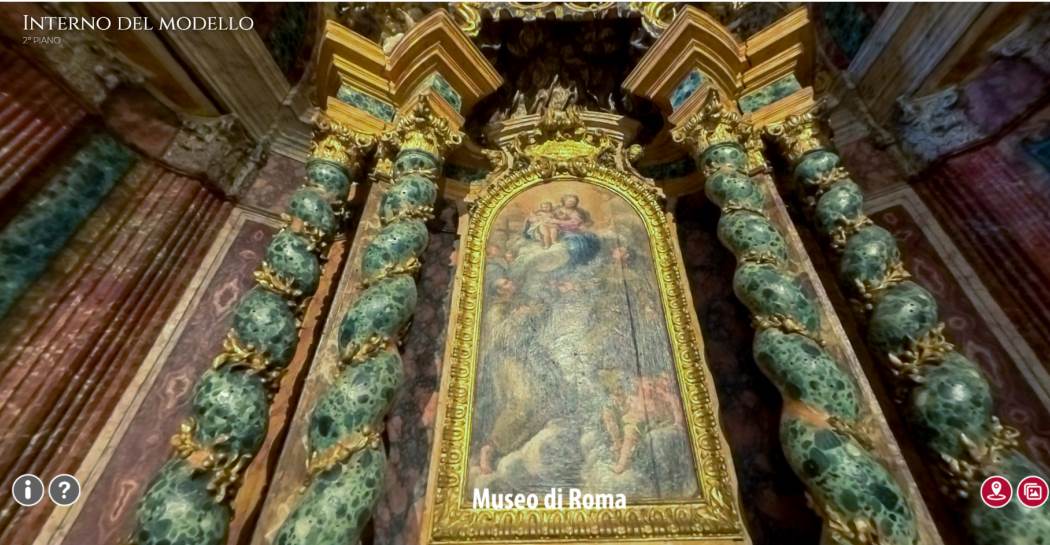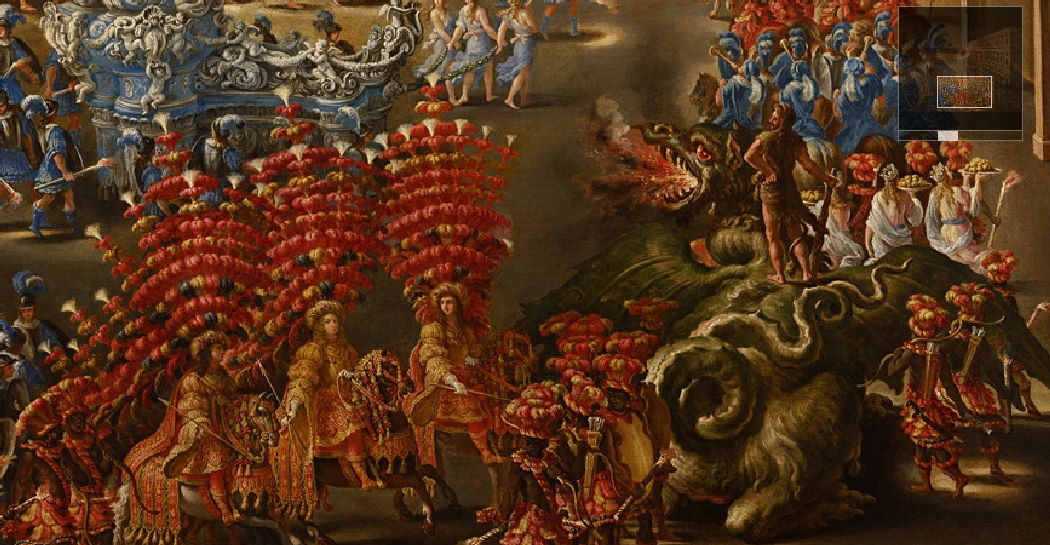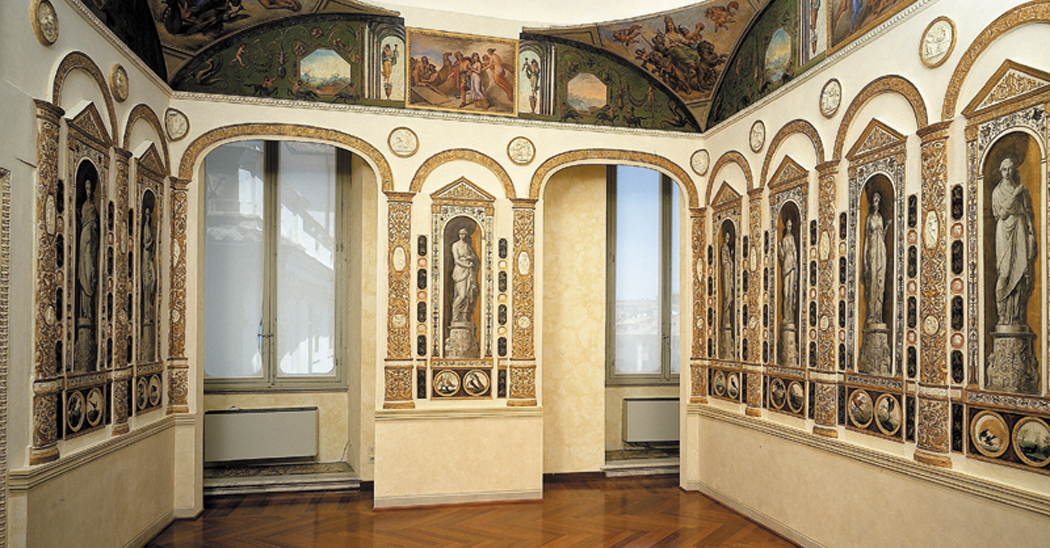Paintings the seventeenth and the eighteenth century
The Museum of Rome has a collection of about 800 paintings by Italian and/or foreign artists who worked in Rome between the seventeenth and the eighteenth century. As regards the paintings of this period , of particular interest are several large seventeenth century canvases, depicting celebrations and historical events, ordered by the Roman families who were prominent in the political and cultural life at that time. Tournament in the Belvedere courtyard, representing the tournament which was played on 5 March 1565, during Carnival, was painted in the first decade of the seventeenth century to celebrate the marriage between Annibale Altemps and Ortensia Borromeo. Another very famous painting by Andrea Sacchi and Filippo Gagliardi, depicts one of the grand performances staged at Palazzo Barberini in honour of Christine of Sweden during the Carnival of 1656. The large painting by Agostino Tassi and Jean Miel to celebrate the election in 1631 of Taddeo Barberini, Urbano VIII's nephew, as the Prefect of Rome portrays the scene of his investiture, performed in the Ara Coeli chapel at the Quirinal Palace, while the painting by Giovanni Senese portrays the procession across of the city, in honour of the Prefect. Andrea Sacchi, Cardinal Antonio Barberini's favourite artist, painted the celebration for the Centenary of the Congregation of Jesus in the Church of Saint Ignatius in 1639.A large number of mid-eighteenth century paintings by Giuseppe Bottani, Augusto Reder and Adrien Manglard have come from the Rospigliosi collection. They portray famous members of the family, celebrations, performances, events linked to the seasons and set in the gardens of the two family residences, the Quirinal or the Esquiline, or even in their properties in Maccarese.Other eighteenth century paintings refer to important historical events. Among these, for example, two large canvases by Alessandro Piazza, portraying the arrival in Naples and the return to the Quirinal of Carlo Barberini, who led a difficult diplomatic mission to Philip V of Spain in Naples in 1702, or even the paintings of an artist, presumably from the Veneto, who depicted in two large views of Rome the magnificent and lively procession in honour of his fellow countryman ambassador Nicola Duodo when he arrived in Rome in 1714 ; or, finally, the two paintings by Pier Leone Ghezzi (1727) on the election of two cardinals during the papacies of Innocence X and Clement XI. Two oil paintings on panels by Felice Giani provide unique pictorial information about the period of the Jacobin Republic in Rome. They illustrate the complicated decorations, inspired by classical monuments, erected in Saint Peter's Square and on the S. Angelo bridge in 1798 for the Federation Day celebrations.Various religious paintings illustrate significant moments of the Roman figurative culture in the seventeenth and eighteenth century. Some examples are: a processional banner belonging to the congregation of St. Francis's Stigmata, ascribed to Guido Reni and coming from the Chigi collection; St. James Minor, by Carlo Maratta, which belongs to a group of paintings of the Twelve Apostles and comes from the Barberini collection; St. Bernard in Adoration of the Instruments of Passion, ascribed to Pier Francesco Mola and Gaspar Dughet, who painted the open landscape in the background; Christ's Blood, the small devotional painting which belonged to Gian Lorenzo Bernini and has been ascribed to Guillaume Curtois. A fine example of the sacred paintings typical of the eighteenth century is Subleyras's canvas, representing St.Camillo De Lellis coming to the rescue of the diseased in the hospital of the Holy Spirit during the flooding of the Tiber in 1598, ordered on the occasion of the canonisation of the Saint in 1746. Other such paintings are Francesco Trevisani's St. Mary Magdalene and the Hermit Saint, or Giuseppe Cades's Holy Virgin served by the angels, a copy of the altarpiece in the Church of St. Nicola of Tolentino, dated approximately 1790. There are quite a large number of portraits representing noblemen, popes and prelates by such well-known painters as Giovanni Battista Gaulli, Carlo Maratta, Ottavio Leoni, Pierleone Ghezzi, Marco Benefial, Subleyras and Pompeo Batoni. The latter is also the author of a portrait of John Staples, a typical image of the Gran Tour in which the noble traveller wanted to be portrayed standing in front of the ancient ruins of the capital city. Some self-portraits and portraits of artists, such as the portrait of Giovanni Battista Piranesi by Pietro Labruzzi, the self-portrait of Antonio Canova and that of Stefano Tofanelli are worthy of note. The series of about 200 portraits of Arcadians coming from the picture gallery of the Academy of Arcadia, created in the second half of the eighteenth century, is a significant document of the culture of that time. A group of eighteenth and nineteenth century portraits, some of which from the Genoese school, have been left to the Museum by the last heir of the Giustiniani Bandini family. Considerable in number are the paintings representing Rome and its surroundings. There are images of churches, basilicas, squares, buildings, ancient ruins, fantastic sights, landscapes with anecdotal scenes, rich in detail, market, street and inn scenes. Among them the works by W. Van Nieulandt, Roeland Van Laer, Franz Franken, J. Lingelbach, Jean Miel, Viviano Codazzi, Van Wittel, Paolo Anesi, Louis Ducros are particularly significant. Three paintings by Gavin Hamilton, portraying the myths of Helen and Paris, are unique documents of the great period of neoclassical decoration in Rome. They come from the Helen and Paris Room in the Villa Borghese for which they were painted in 1786 during the restructuring of the Villa commissioned by Marcantonio Borghese who called in the most famous artists in the figurative culture of that time to do the work.


























